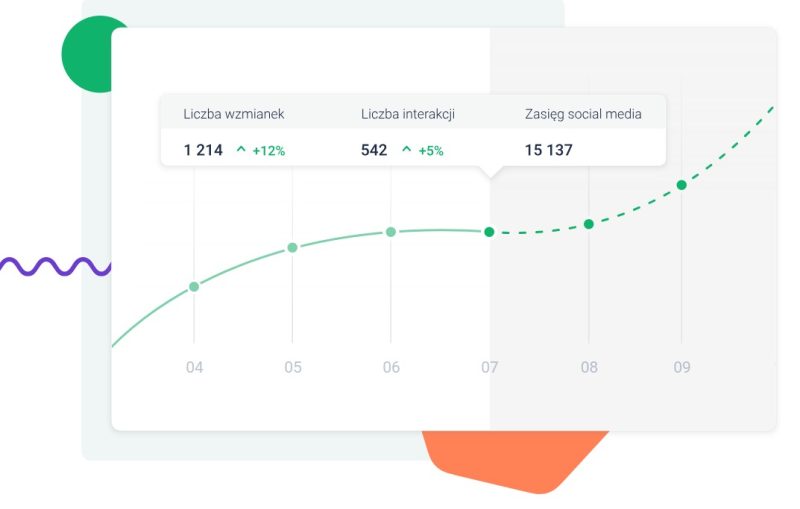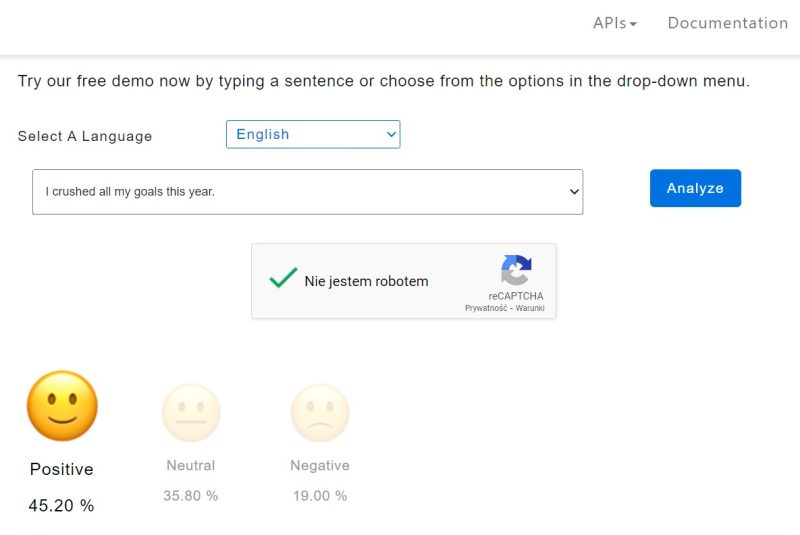In the era of digital transformation, companies have access to an unprecedented amount of data about their customers – their opinions, feelings, and experiences. The key to success is the ability to quickly analyze this information and draw conclusions. Artificial intelligence and automated sentiment analysis come to the rescue. Thanks to them, thousands of opinions can be analyzed in minutes to discover what customers think about products or services. How does it work in practice? What benefits does it bring to companies? How to implement sentiment analysis in your organization? You will find answers to these questions in the article below.
Sentiment analysis with AI – table of contents
What is sentiment analysis?
Sentiment analysis, also known as opinion mining, is the process of automatically processing large amounts of text to determine whether it expresses positive, negative, or neutral emotions. It relies on natural language processing (NLP), which enables machines to understand human language, and machine learning (ML) – training algorithms on labeled datasets to recognize specific words and expressions indicating a particular sentiment.
The main methods of sentiment analysis:
- rule-based approach – assigning appropriate emotions to keywords based on predefined rules and dictionaries, for example, “great” – positive, “terrible” – negative. It’s quick, but less accurate,
- machine learning approach – it is based on training algorithms on labeled datasets, so they can learn to recognize sentiment based on context. It is more advanced and requires a lot of training data.
- hybrid approach – combining both approaches.
Imagine a clothing company that wants to gather feedback on its new collection from social media, forums, and surveys. Doing this manually would take weeks. With AI and sentiment analysis, it takes minutes. The algorithm assigns a score to each opinion, from -1 to 1, where -1 is very negative, 0 is neutral, and 1 is very positive. This helps the company quickly see which products customers like and which need improvement.
The following outline shows the process of sentiment analysis using AI:
- Gathering data. In the first step, customer reviews are collected from various sources.
- Pre-processing. It involves removing special characters, emoticons, HTML tags, etc.
- Tokenization. It’s breaking down text into individual words or phrases so that artificial intelligence can process textual information more efficiently.
- Linguistic analysis. Identifying parts of speech, recognizing negation, comparatives, and superlatives, etc.
- Sentiment classification. A key moment that involves assigning a positive, neutral, or negative label.
- Results aggregation. This is the calculation of the overall sentiment for a given set of opinions.
Such prepared data serve as an excellent starting point for further analysis and drawing business conclusions. Thanks to the automation of the process, companies can continuously monitor customer sentiments and quickly respond to emerging signals.

Source: DALL·E 3, prompt: Marta M. Kania (https://www.linkedin.com/in/martamatyldakania/)
Why is sentiment analysis important for businesses?
Tracking what customers say about a brand online is crucial for businesses today. Analyzing hundreds of comments and posts manually is just too much work.
Automated sentiment analysis helps keep an eye on brand mentions in real time and respond quickly. Here are the key uses:
- improving customer service – identifying and responding to negative feedback quickly,
- protecting reputation – continuous monitoring of brand sentiment helps prevent reputational crises,
- market research – tracking trends, benchmarking against competitors, and discovering niches. According to research, 90% of purchase decisions are preceded by online research.
- product development – collecting user feedback and analyzing it for improvements and innovations.
Examples? A restaurant chain can analyze guest reviews on platforms like TripAdvisor to improve the quality of dishes and service. A bank can track sentiment towards a new mobile app to promptly address any issues and tailor features to user needs. A natural cosmetics manufacturer can monitor discussions on forums and Facebook groups to discover a niche for a new product.
Coca-Cola used sentiment analysis to track conversations about the brand on social media during the 2018 FIFA World Cup. This allowed them to adjust their advertising message in real time.
T-Mobile, in turn, thanks to sentiment analysis, identified the main issues of customers and implemented improvements, which resulted in a 73% decrease in complaints.
As you can see, there are practically limitless applications for sentiment analysis. The key is to effectively translate the insights gained into actionable optimization strategies.
How to leverage the results of sentiment analysis obtained with AI?
Sentiment analysis provides valuable insights, but the real value emerges when we translate them into specific actions.
- personalizing customer communication, such as automatically adjusting the chatbot’s tone based on the user’s mood,
- customer segmentation and better matching of offers, as well as identifying the main pain points of users of a given product,
- optimizing marketing campaigns based on emotional reactions to the message,
- quick response to emerging crises and prevention of escalation through immediate intervention,
- improving products and services according to customer expectations expressed in online reviews.
Imagine sentiment analysis shows that customers complain about long wait times on the hotline. By implementing a voicebot to handle some inquiries, you can significantly reduce queues and increase caller satisfaction. If the voicebot software detects that users are praising a new feature in the app, it’s worth leveraging that insight in a product promotion campaign.
Real-time sentiment analysis is a powerful crisis management tool. By catching the first negative signals, you can respond quickly before a crisis escalates. Effective communication and honesty are key – customers appreciate when a company admits a mistake and shows how it plans to fix it.
The key advantage of using AI for sentiment analysis is speed and scale. Manually, we can analyze at most a few hundred opinions. Meanwhile, AI tools can process hundreds of thousands of mentions in minutes, providing an up-to-date picture of the situation. This enables making accurate decisions here and now.
Top AI sentiment analysis tools
There are many tools available on the market that use AI for sentiment analysis. They differ in features, interface, and price. Among the most popular are Brand24, Hootsuite Insights, and Komprehend.
Brand24
Brand24 (https://brand24.pl/) is a Polish tool for internet monitoring and sentiment analysis. It collects mentions from social media, websites, forums, blogs, etc. It automatically labels sentiment as positive, neutral, or negative. It generates reports and statistics regarding the number of mentions and reach.
Brand24 offers a free 14-day trial period, and prices start at 99 PLN/month. It works great for small and medium-sized businesses, especially in e-commerce and services. It stands out for its ease of use and clear reports.

Source: Brand24 (https://brand24.pl/)
Hootsuite Insights
Hootsuite Insights (https://www.hootsuite.com/products/insights) is a powerful tool for social listening. It analyzes data from over 100 million sources in 50 languages, providing detailed insights into sentiment, trends, and benchmarks. Demos are available upon request, with prices tailored to individual needs. It’s great for medium to large companies and integrates seamlessly with major social media platforms.

Source: Hootsuite (https://www.hootsuite.com/products/insights)
Komprehend
Komprehend (https://komprehend.io/sentiment-analysis) is a deep learning-based API for sentiment analysis. It recognizes three sentiment states: positive, neutral, and negative, supporting 14 languages, including Polish. With ready integrations and flexible deployment, it’s a reliable choice. The free plan offers 5000 queries per month, with additional queries priced at $0.0001 each for larger companies. Komprehend is ideal for backend use in apps and chatbots, known for its high-quality analysis proven in competitions like SemEval.

Source: Komprehend (https://komprehend.io/sentiment-analysis)
Choosing the right tool depends on a company’s individual needs and budget. It is worth testing different options and choosing the one that best fits the specifics of your business.
Summary
In the digital age, sentiment analysis has become an indispensable tool in the arsenal of modern businesses. The amount of data generated by users is overwhelming, but artificial intelligence can help. Thanks to advanced algorithms, we can instantly analyze millions of opinions and draw conclusions. This is invaluable knowledge for customer service, marketing, or R&D departments.
The key benefits of using sentiment analysis in business are:
- saving time and resources by automating data processing,
- constant monitoring of customer feedback and immediate response to signals,
- better customer segmentation and tailored offerings,
- optimizing marketing campaigns based on feedback,
- quickly spotting market trends and anticipating changes,
- handling crises better and protecting brand reputation,
- continuously improving products and services to meet customer expectations.
Of course, sentiment analysis is just the beginning. The key is to effectively use the insights it provides. Speed of response and aligning strategies with customer expectations are crucial. Brands that can listen and quickly respond to customer feedback gain a competitive edge. AI provides them with tools to do this efficiently and at scale.
The future of sentiment analysis looks very promising. AI models will enhance accuracy, incorporating contextual analysis and multimodal inputs like images, sound, and video. Awareness of the importance of customer opinions and the role of customer experience will also increase. Businesses investing in AI tools for sentiment analysis now will reap benefits tomorrow with loyal customers, a solid market position, and outstanding products. Let’s not waste this opportunity.

If you like our content, join our busy bees community on Facebook, Twitter, LinkedIn, Instagram, YouTube, Pinterest, TikTok.
Author: Robert Whitney
JavaScript expert and instructor who coaches IT departments. His main goal is to up-level team productivity by teaching others how to effectively cooperate while coding.
AI in business:
- Threats and opportunities of AI in business (part 1)
- Threats and opportunities of AI in business (part 2)
- AI applications in business - overview
- AI-assisted text chatbots
- Business NLP today and tomorrow
- The role of AI in business decision-making
- Scheduling social media posts. How can AI help?
- Automated social media posts
- New services and products operating with AI
- What are the weaknesses of my business idea? A brainstorming session with ChatGPT
- Using ChatGPT in business
- Synthetic actors. Top 3 AI video generators
- 3 useful AI graphic design tools. Generative AI in business
- 3 awesome AI writers you must try out today
- Exploring the power of AI in music creation
- Navigating new business opportunities with ChatGPT-4
- AI tools for the manager
- 6 awesome ChatGTP plugins that will make your life easier
- 3 grafików AI. Generatywna sztuczna inteligencja dla biznesu
- What is the future of AI according to McKinsey Global Institute?
- Artificial intelligence in business - Introduction
- What is NLP, or natural language processing in business
- Automatic document processing
- Google Translate vs DeepL. 5 applications of machine translation for business
- The operation and business applications of voicebots
- Virtual assistant technology, or how to talk to AI?
- What is Business Intelligence?
- Will artificial intelligence replace business analysts?
- How can artificial intelligence help with BPM?
- AI and social media – what do they say about us?
- Artificial intelligence in content management
- Creative AI of today and tomorrow
- Multimodal AI and its applications in business
- New interactions. How is AI changing the way we operate devices?
- RPA and APIs in a digital company
- The future job market and upcoming professions
- AI in EdTech. 3 examples of companies that used the potential of artificial intelligence
- Artificial intelligence and the environment. 3 AI solutions to help you build a sustainable business
- AI content detectors. Are they worth it?
- ChatGPT vs Bard vs Bing. Which AI chatbot is leading the race?
- Is chatbot AI a competitor to Google search?
- Effective ChatGPT Prompts for HR and Recruitment
- Prompt engineering. What does a prompt engineer do?
- AI Mockup generator. Top 4 tools
- AI and what else? Top technology trends for business in 2024
- AI and business ethics. Why you should invest in ethical solutions
- Meta AI. What should you know about Facebook and Instagram's AI-supported features?
- AI regulation. What do you need to know as an entrepreneur?
- 5 new uses of AI in business
- AI products and projects - how are they different from others?
- AI-assisted process automation. Where to start?
- How do you match an AI solution to a business problem?
- AI as an expert on your team
- AI team vs. division of roles
- How to choose a career field in AI?
- Is it always worth it to add artificial intelligence to the product development process?
- AI in HR: How recruitment automation affects HR and team development
- 6 most interesting AI tools in 2023
- 6 biggest business mishaps caused by AI
- What is the company's AI maturity analysis?
- AI for B2B personalization
- ChatGPT use cases. 18 examples of how to improve your business with ChatGPT in 2024
- Microlearning. A quick way to get new skills
- The most interesting AI implementations in companies in 2024
- What do artificial intelligence specialists do?
- What challenges does the AI project bring?
- Top 8 AI tools for business in 2024
- AI in CRM. What does AI change in CRM tools?
- The UE AI Act. How does Europe regulate the use of artificial intelligence
- Sora. How will realistic videos from OpenAI change business?
- Top 7 AI website builders
- No-code tools and AI innovations
- How much does using AI increase the productivity of your team?
- How to use ChatGTP for market research?
- How to broaden the reach of your AI marketing campaign?
- "We are all developers". How can citizen developers help your company?
- AI in transportation and logistics
- What business pain points can AI fix?
- Artificial intelligence in the media
- AI in banking and finance. Stripe, Monzo, and Grab
- AI in the travel industry
- How AI is fostering the birth of new technologies
- The revolution of AI in social media
- AI in e-commerce. Overview of global leaders
- Top 4 AI image creation tools
- Top 5 AI tools for data analysis
- AI strategy in your company - how to build it?
- Best AI courses – 6 awesome recommendations
- Optimizing social media listening with AI tools
- IoT + AI, or how to reduce energy costs in a company
- AI in logistics. 5 best tools
- GPT Store – an overview of the most interesting GPTs for business
- LLM, GPT, RAG... What do AI acronyms mean?
- AI robots – the future or present of business?
- What is the cost of implementing AI in a company?
- How can AI help in a freelancer’s career?
- Automating work and increasing productivity. A guide to AI for freelancers
- AI for startups – best tools
- Building a website with AI
- OpenAI, Midjourney, Anthropic, Hugging Face. Who is who in the world of AI?
- Eleven Labs and what else? The most promising AI startups
- Synthetic data and its importance for the development of your business
- Top AI search engines. Where to look for AI tools?
- Video AI. The latest AI video generators
- AI for managers. How AI can make your job easier
- What’s new in Google Gemini? Everything you need to know
- AI in Poland. Companies, meetings, and conferences
- AI calendar. How to optimize your time in a company?
- AI and the future of work. How to prepare your business for change?
- AI voice cloning for business. How to create personalized voice messages with AI?
- Fact-checking and AI hallucinations
- AI in recruitment – developing recruitment materials step-by-step
- Midjourney v6. Innovations in AI image generation
- AI in SMEs. How can SMEs compete with giants using AI?
- How is AI changing influencer marketing?
- Is AI really a threat to developers? Devin and Microsoft AutoDev
- AI chatbots for e-commerce. Case studies
- Best AI chatbots for ecommerce. Platforms
- How to stay on top of what's going on in the AI world?
- Taming AI. How to take the first steps to apply AI in your business?
- Perplexity, Bing Copilot, or You.com? Comparing AI search engines
- ReALM. A groundbreaking language model from Apple?
- AI experts in Poland
- Google Genie — a generative AI model that creates fully interactive worlds from images
- Automation or augmentation? Two approaches to AI in a company
- LLMOps, or how to effectively manage language models in an organization
- AI video generation. New horizons in video content production for businesses
- Best AI transcription tools. How to transform long recordings into concise summaries?
- Sentiment analysis with AI. How does it help drive change in business?
- The role of AI in content moderation


















